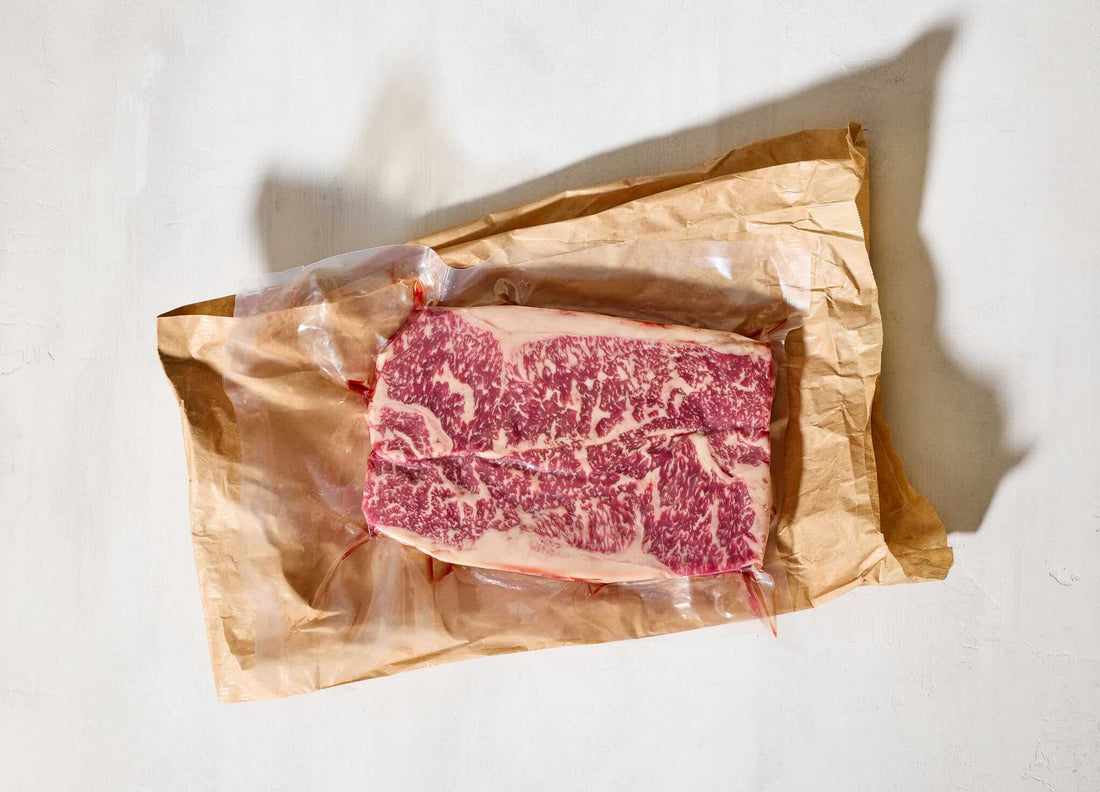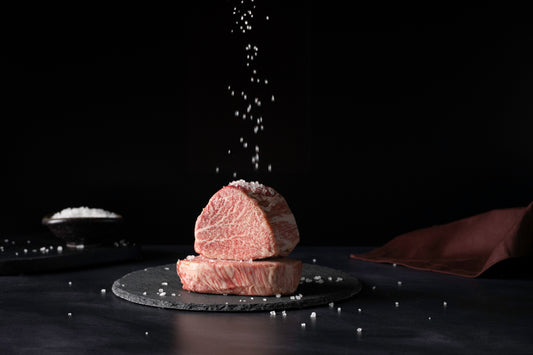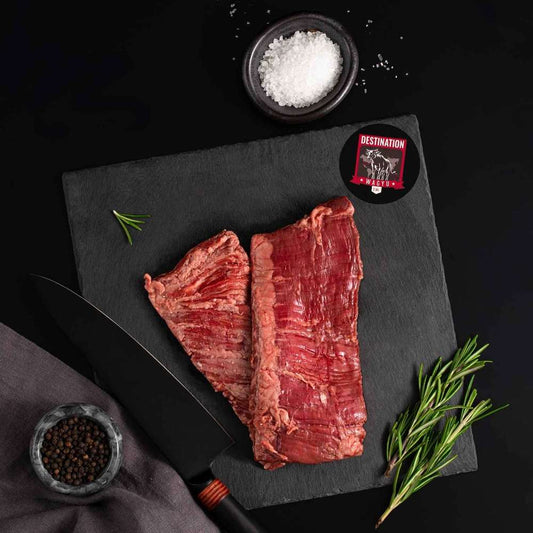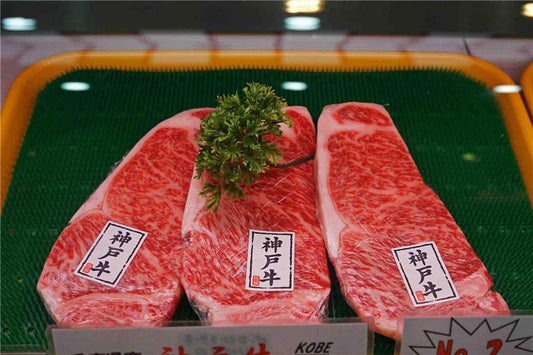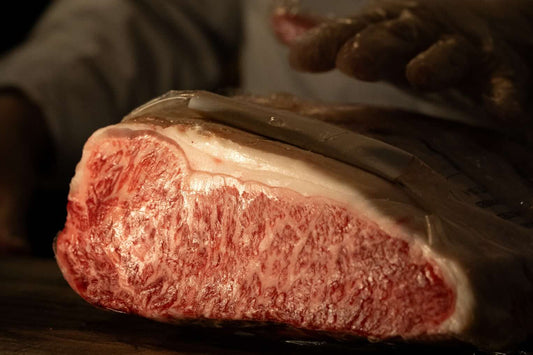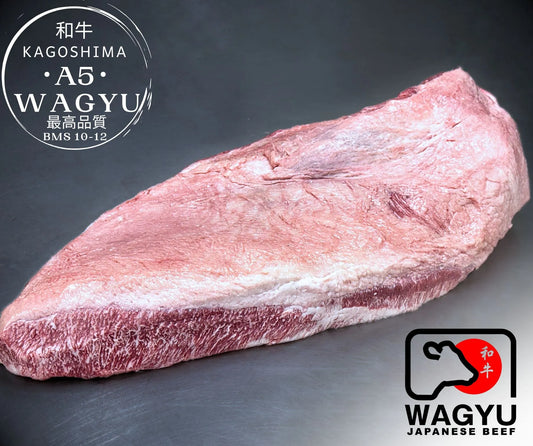-
True Wagyu beef originates from four Japanese breeds, with Kuroge Washu producing over 90% due to its superior marbling.
-
Japanese Wagyu is graded using the JMGA system, with BMS scores from 1–12; a BMS 12 is extremely rare and prized.
-
Fullblood Wagyu has pure lineage and higher marbling than crossbred variants, which are categorized from F1 (50%) to F4 (93.75%).
Over the past twenty years, I’ve watched the global beef market undergo a dramatic transformation, and nothing has disrupted expectations quite like Wagyu. What was once an insular, hyper-regional delicacy confined to select prefectures in Japan has become a worldwide benchmark for luxury beef. But with increased exposure has come increased confusion, and even among professionals, there’s often an imprecise understanding of what Wagyu truly represents. The goal of this guide is not to romanticize Wagyu, but to provide a clinical and practical breakdown of its anatomy, quality metrics, procurement pathways, and optimal usage in a fine-dining or specialty retail context.
Wagyu, for those of us who work with meat day in and day out, is not just another premium protein. It occupies a unique biological and gastronomic niche defined by extreme intramuscular marbling, low melting point fats, and a gene pool that has been refined through centuries of closed-herd breeding. Unlike other beef, Wagyu demands a precise approach at every level of the supply chain from genetics and grading to storage and thermal processing. This is a product that doesn’t tolerate error. It magnifies missteps as easily as it rewards technique.
In this guide, I will explore the core aspects that shape Wagyu's value and performance, with a particular focus on wagyu beef steak applications. Whether you're a meat buyer, executive chef, specialty butcher, or vertical-integrated supplier, you’ll find frameworks here that you can apply immediately to your sourcing, handling, and culinary operations. We are not going to cover generalizations or rehash promotional talking points. This is a thorough research written for professionals by a professional, informed by years of direct experience with A5 carcasses, Wagyu breeding operations, international import regulations, and countless hours of back-of-house application.
Let’s begin with what sets Wagyu apart at the source: genetics.
Wagyu Genetics and Breed Lineage
The Four Foundational Japanese Breeds
When discussing Wagyu, it’s critical to understand that not all Japanese cattle qualify. The term "Wagyu" literally translates to “Japanese cow,” but in the meat industry, we are specifically referring to four native breeds: Kuroge Washu (Japanese Black), Akage Washu (Japanese Brown), Nihon Tankaku (Japanese Shorthorn), and Mukaku Washu (Japanese Polled). Each of these breeds has distinct characteristics that influence marbling, texture, and flavor outcomes, though the overwhelming majority of commercial Wagyu production over 90 percent comes from Kuroge Washu.
Kuroge Washu is prized for its extraordinary capacity to produce fine, uniform intramuscular marbling. This is not incidental. Over centuries, this breed was selectively refined not for draft utility like other Japanese cattle, but for specific meat quality traits. In contrast, Akage Washu, often found in the Kumamoto region, produces leaner carcasses with a nuttier flavor, though it lacks the same high-level marbling capabilities. Nihon Tankaku is a lesser-known breed with a strong mineral and iron profile, often favored for yakiniku applications. Mukaku Washu, the rarest of the four, has essentially disappeared from large-scale production, although a few boutique operations maintain its line.
Fullblood vs Crossbred Wagyu
Understanding Wagyu classification also means grasping the distinction between fullblood and crossbred animals. Fullblood Wagyu is derived from a continuous, unmixed genetic line that traces directly back to Japanese ancestors. These cattle are registered in breed associations with pedigree documentation stretching back several generations. They typically represent the most expensive and highly marbled carcasses, especially when raised under Japanese feeding protocols.
Crossbred Wagyu, on the other hand, refers to cattle that contain varying percentages of Wagyu genetics, often introduced through sires bred into Angus or Holstein dams. The most common classification schema includes F1 (50% Wagyu), F2 (75%), F3 (87.5%), and F4 (93.75%). While F4s are sometimes misleadingly marketed as “purebred,” they still lack the complete expression of traits seen in true fullblood cattle. From a production standpoint, crossbreeding can make sense in environments where feed efficiency and carcass yield are prioritized over absolute marbling density.
Global Distribution of Wagyu Genetics
The export of Wagyu genetics began in earnest during the 1990s, particularly to the United States and Australia. However, Japan soon realized the strategic value of its cattle and enacted strict export bans, meaning that nearly all non-Japanese Wagyu herds descend from a very limited genetic pool. For example, the original exports to the U.S. involved just a few dozen animals. Today, both the American Wagyu Association and the Australian Wagyu Association maintain studbooks and genomic registries to monitor lineage purity and prevent further genetic dilution.
This limited diversity has led to heavy reliance on artificial insemination and embryo transfer, with many producers working from a few dominant sire lines like Itoshigenami, Shigeshigetani, and Michifuku. The bottleneck effect is real, and it presents both challenges and opportunities for breed development and trait optimization.
Genetic Traits Related to Marbling
A particularly important set of genes in Wagyu production are those related to lipid metabolism and marbling expression. The stearoyl-CoA desaturase (SCD) gene, for instance, governs the conversion of saturated fatty acids to monounsaturated ones. Certain polymorphisms of SCD are associated with higher concentrations of oleic acid, which contributes to Wagyu's signature soft fat and low melting point. Similarly, the FASN gene influences total fat deposition and adipocyte activity.
Genetic testing for these traits is becoming more common, especially in breeding operations that focus on maximizing carcass value rather than volume. Understanding how these genes interact with feed protocols and slaughter timing is essential for any operation aiming to produce elite-level beef on a consistent basis.
Grading and Evaluation Systems
Japanese Meat Grading Association (JMGA)
When we evaluate Wagyu, particularly from Japan, the gold standard is the JMGA grading system. This system is both rigorous and nuanced, combining yield and quality assessments into a composite grade. The yield grade, ranked from A to C, measures the ratio of meat to total carcass weight, with "A" representing the highest yield. Quality grade, on the other hand, ranges from 1 to 5 and evaluates four key attributes: marbling, meat color and brightness, firmness and texture of meat, and color, luster, and quality of fat.
The Beef Marbling Standard (BMS) score is perhaps the most closely scrutinized component. Scored on a scale from 1 to 12, it represents the fineness, distribution, and volume of intramuscular fat. A BMS of 12 is exceptionally rare, typically representing fewer than one percent of graded carcasses. Grading is performed by trained evaluators who assess the ribeye cross-section between the sixth and seventh ribs, following detailed visual references that guide the BMS assessment.
What makes the JMGA system effective is its standardization and national enforcement. Each carcass is inspected in a government-approved facility by certified graders whose training often takes years. Their consistency is tightly monitored, and the results are publicly recorded, allowing buyers to verify grades and track producer performance over time. This degree of transparency is one of the reasons Japanese Wagyu retains such a dominant position in the luxury meat market.
Australian AUS-MEAT and MSA Systems
Australia has emerged as the second most prominent Wagyu producer globally, thanks in large part to its willingness to invest in fullblood and F4 genetic lines. The country relies on the AUS-MEAT system, which is broadly similar to the JMGA structure but uses different scales and assessment criteria. Marbling is scored from MS 1 to 9, with some programs extending that up to 12 for ultra-premium Wagyu. However, unlike Japan, Australia incorporates additional factors like P8 fat depth, ossification score, and meat pH through the Meat Standards Australia (MSA) system.
The Australian grading model attempts to quantify eating quality by integrating data from numerous muscle groups and physiological indicators. In many ways, it is more complex than the JMGA model. It not only assesses visual marbling but also considers how the beef will perform during cooking and consumption. This predictive model is useful for commercial buyers looking to balance quality and consistency across a range of cuts.
That said, variability in grading execution across abattoirs does exist. Not all facilities maintain the same calibration protocols, and this can introduce inconsistencies that are problematic at scale. I recommend working only with producers who submit their grading data for third-party verification or who participate in full traceability programs.
United States Grading and the Role of the AWA
The United States employs the USDA grading system, which is significantly less specific when it comes to high-marbled beef. USDA Prime, the top tier, encompasses all beef with abundant marbling, but it does not differentiate between a traditional high-end Angus carcass and a BMS 10 Wagyu ribeye. As a result, many American Wagyu producers have developed their own proprietary marbling scales or rely on third-party evaluators to bridge the gap between USDA grading and true Wagyu differentiation.
The American Wagyu Association (AWA) does offer breed registry and documentation services, but the grading remains a weak point. Without a nationally enforced marbling scale beyond Prime, buyers must rely heavily on vendor integrity, processing plant consistency, and visual inspection. Some programs, particularly those modeled on Japanese standards, offer hybrid grading certificates that include both USDA and Wagyu-style evaluations.
For buyers in the United States, the lack of a standardized Wagyu grading scale means that due diligence is critical. Look for programs that disclose BMS-style scoring or provide detailed carcass data beyond USDA labels. Where possible, request photos of the ribeye cross-section or ask for direct grading sheets from the packing facility.
Cross-System Comparison and Practical Implications
It’s important to note that BMS, MS, and USDA Prime do not align neatly. A BMS 12 wagyu beef steak would fall well beyond the scope of USDA Prime, while an MS 9 Australian Wagyu may present more like a BMS 6 or 7. Below is a general equivalency guide, although it should be used cautiously:
-
USDA Prime: Roughly equivalent to BMS 3–5
-
MS 5–6 (AUS): BMS 6–7 (JPN)
-
MS 9+: BMS 10–12 (Elite Japanese Wagyu)
The practical implication of this mismatch is significant. A buyer who assumes all “Prime” Wagyu is of equivalent quality will often overpay for a product that lacks the visual and textural performance of true Japanese or Australian fullblood Wagyu. To mitigate this, experienced buyers must always calibrate expectations based on carcass data, visual cues, and supplier track record, rather than relying on national grading shorthand.
Wagyu Beef Steak Cuts: Advanced Butchery and Yield Science
High-Value Primary Cuts
In high-end foodservice and specialty retail, Wagyu beef steak cuts are selected not just for their tenderness but for their marbling architecture and cooking performance. The ribeye, striploin, and tenderloin remain the most commercially desirable, but each presents its own advantages and operational challenges.
The ribeye, particularly when broken down into the eye and the spinalis dorsi (also known as the rib cap), is a showpiece cut. In Japanese butchery, the rib cap is often removed and served separately, highlighting its extremely high marbling and buttery mouthfeel. However, this same fat density can make it difficult to cook evenly. A BMS 11 rib cap can break down too quickly under direct heat, leading to flare-ups and uneven texture.
The striploin offers a more balanced experience, with a slightly firmer bite and a straighter grain that holds up well under a broader range of cooking methods. It also presents beautifully when sliced, thanks to its linear marbling and consistent shape. The tenderloin, while extremely soft, has relatively less marbling in Wagyu and can be considered a textural indulgence rather than a flavor-driven one. I often caution buyers not to overvalue the tenderloin simply because it’s tender. Its flavor profile does not compete with the spinalis or zabuton.
Secondary and Alternative Cuts with Gourmet Potential
In recent years, I’ve seen an increasing interest in non-traditional Wagyu beef steak cuts. The zabuton, known in the US as the Denver steak, is a standout. Cut from the chuck underblade, this muscle is richly marbled, but with a firmer chew and an intense beef flavor that outperforms many loin cuts. When portioned correctly, it rivals the ribeye in sensory impact at a much lower cost per pound.
Chuck eye roll is another underutilized Wagyu cut that delivers exceptional value. It sits just anterior to the ribeye and carries similar muscle groups with slightly more connective tissue. Proper dry aging or wet aging can render this tissue down and bring the cut into fine dining territory. Other cuts like the tri-tip, flat iron (misuji), and harami (inside skirt) have gained traction in yakiniku-style applications and boutique tasting menus. Their flavor concentration is high, and when Wagyu genetics are involved, they can outperform traditional loin cuts in umami and texture.
Anatomical and Yield Considerations
Understanding the internal fat structure and seam muscle divisions is key to extracting value from a Wagyu carcass. Unlike conventional beef, Wagyu has a much higher ratio of seam fat and a lower yield of usable lean meat. This means that butchers must be more precise in their trimming practices. A miscut on a BMS 11 carcass doesn’t just reduce yield, it destroys the visual value that the buyer is paying for.
Portioning also needs to account for fat melt during cooking. Wagyu beef steaks thicker than 1.25 inches tend to perform better with Wagyu, especially high BMS cuts, because they allow more control over internal temperature while rendering fat. Thin cuts risk turning greasy rather than luxurious if not handled with care. Training your butchery team on Wagyu-specific breakdown protocols is essential if you're going to maximize both yield and presentation.
Dry Aging Compatibility
There’s been a surge of interest in dry-aged Wagyu, but not all cuts or marbling levels are compatible with this process. The high fat content in Wagyu introduces risks that are less common with leaner beef, including fat rancidity and uneven enzymatic breakdown. In my experience, dry aging Wagyu beyond 30 days requires precise humidity control and frequent monitoring. Cuts like the ribeye and striploin can benefit from aging, gaining depth and complexity, but extremely high BMS steaks (10 to 12) often suffer from texture degradation and off-aroma if aged improperly.
If you’re exploring dry aging as a value-add, I recommend starting with BMS 6 to 8 products and limiting aging to 21 to 28 days until you dial in your environmental controls. Always use full loins or sub-primals rather than individual wagyu beef steaks to reduce moisture loss and protect the fat layer. And remember, not every customer is going to understand the flavor profile of dry-aged Wagyu. Educating your clientele is just as important as executing the process well.
Fat Composition, Texture, and Flavor Chemistry
Unique Fatty Acid Profile of Wagyu
One of the most defining characteristics of Wagyu beef is its fat composition. Unlike conventional beef breeds, Wagyu has an exceptionally high concentration of monounsaturated fatty acids, particularly oleic acid. This results in a dramatically different eating experience. The fat in Wagyu begins to melt at approximately 25 degrees Celsius, which is significantly lower than that of standard beef fat. This means the meat will start to soften and render at body temperature, delivering a luxurious mouthfeel that coats the palate without feeling greasy or heavy.
What drives this biochemical profile is the breed’s unique lipid metabolism. Wagyu cattle express high levels of the stearoyl-CoA desaturase (SCD) enzyme, which converts saturated fats into unsaturated ones. The presence of specific polymorphisms in the SCD gene is directly correlated with the beef's ability to produce fine marbling and soft fat. Other relevant genes, such as FASN (fatty acid synthase), contribute to the overall volume of lipid deposition, influencing both marbling density and the ratio of subcutaneous to intramuscular fat.
The net effect of this composition is a dramatically different cooking behavior. When exposed to heat, Wagyu fat renders cleanly and rapidly. This enhances aroma development and helps sear the meat evenly, but it also requires precise control to avoid flare-ups and burning. Chefs must adjust their cooking techniques to accommodate the delicate nature of Wagyu fat, especially when dealing with cuts rated BMS 9 and above.
Marbling Fineness and Distribution
Not all marbling is created equal. In Wagyu, it’s not just the quantity of marbling that matters but also the distribution and fineness of the fat within the muscle. Coarse, uneven marbling leads to inconsistent cooking results and a patchy texture. In contrast, the best Wagyu features spiderweb-like veins of fat distributed homogeneously throughout the muscle fibers. This type of marbling breaks down evenly during cooking, lubricating the muscle tissue and enhancing flavor without disrupting structure.
Wagyu from Japan, particularly from prefectures like Miyazaki and Kagoshima, is known for this fine marbling architecture. Australian and American Wagyu can also produce excellent marbling, but due to genetic diversity and feeding regimes, the consistency may vary more. Visual inspection of the ribeye cross-section remains one of the most reliable ways to gauge marbling quality, especially when combined with documentation from a credible grading body.
Fineness of marbling also plays a role in how the fat interacts with the meat fibers. Fine marbling intercalates with the grain of the muscle, meaning it melts into the meat rather than separating from it. This creates a cohesive bite with balanced juiciness and umami. When marbling is coarse, fat tends to pool and render unevenly, which can lead to greasy mouthfeel and uneven flavor distribution.
Flavor Development and Volatile Compounds
The flavor profile of Wagyu is profoundly influenced by its fat content and fatty acid structure. During cooking, the breakdown of triglycerides and the Maillard reaction combine to release a range of volatile compounds that contribute to aroma and flavor. Wagyu beef contains elevated levels of lactones, aldehydes, and ketones, many of which are fat-soluble and therefore more abundant in high-marbling beef.
These volatiles create the distinctive sweet, nutty, and buttery aromas associated with top-grade Wagyu. Additionally, the presence of inosinic acid, a nucleotide-derived umami compound, enhances savory perception on the palate. This compound interacts synergistically with glutamic acid, another naturally occurring component in beef, to amplify umami intensity. These compounds are particularly concentrated in dry-aged Wagyu, which undergoes enzymatic breakdown of proteins and lipids that release additional free amino acids and nucleotides.
Cooking methods and temperature have a strong influence on the activation of these compounds. For example, searing at high temperature over charcoal can enhance aromatic complexity, while sous-vide cooking preserves the fat profile but may suppress some of the volatile release unless finished with a hard sear. Understanding the chemistry of these flavor drivers allows chefs and culinary teams to tailor preparation methods to maximize flavor impact.
Handling and Oxidation Considerations
Because Wagyu fat has a higher percentage of unsaturated fatty acids, it is also more susceptible to oxidation. This is a critical consideration during storage, transport, and even in open kitchen environments. Oxidized fat not only deteriorates in flavor but also produces off-aromas that are especially noticeable in high-grade meat. Color changes, particularly in the fat, are early signs of oxidation and should not be ignored.
To mitigate this, Wagyu should be stored in vacuum-sealed bags with minimal oxygen exposure and held at consistent cold temperatures. Avoid fluctuating refrigeration conditions, as condensation and temperature shifts can accelerate degradation. If you’re displaying Wagyu cuts in a retail or open-kitchen environment, limit exposure to light and rotate product frequently to prevent color fade and oxidative breakdown.
In long-term storage, freezing Wagyu presents its own challenges. Traditional freezing can lead to fat crystallization and texture loss. Instead, rapid freezing using blast freezers or cryogenic methods is recommended. These approaches preserve cell structure and prevent the fat from separating or breaking the muscle grain upon thawing. Thawing must also be done gently, ideally over 24 to 48 hours in a refrigeration unit, to maintain integrity.
Sourcing and Buying Wagyu: Professional Procurement Protocols
Verification of Lineage and Authenticity
With the global demand for Wagyu growing, so too has the number of imitations and misrepresentations in the marketplace. Ensuring authenticity is a critical step in professional procurement. For Japanese Wagyu, this begins with the cattle identification system. Every animal born in Japan is issued a unique 10-digit identification number linked to the national cattle registry. This number tracks the animal’s birth date, breed, sex, lineage, slaughterhouse, and carcass grade. When purchasing Japanese Wagyu, always request this ID and cross-check it using the Japanese government’s online verification portal.
In Australia and the United States, breed associations such as the Australian Wagyu Association and the American Wagyu Association maintain studbooks and pedigree records. These organizations can confirm whether a particular product is from a fullblood line or a crossbred line. For high-stakes purchasing, especially for whole carcasses or large-volume contracts, it is advisable to request DNA confirmation or at minimum, third-party certification of lineage and feeding protocols.
Working with Reputable Distributors
Finding the right distributor is as important as selecting the right breed and cut. Not all suppliers operate with the same level of transparency or logistical competence. A reputable Wagyu distributor should be able to provide full documentation on grading, lineage, slaughter date, and cold chain history. They should also have direct relationships with ranchers or cooperatives, rather than operating as secondary brokers.
Always ask for a sample cut or carcass image prior to committing to a large order. Digital grading images of the ribeye section can reveal much about marbling, trim quality, and carcass handling. If the distributor cannot provide this level of detail, consider it a red flag.
Whole Carcass vs Primal vs Portioned Cuts
Procurement strategy depends heavily on operational context. High-volume steakhouses or butcher shops may benefit from purchasing whole or half carcasses, which offer better cost efficiency and more control over portioning. However, working with whole carcasses requires skilled butchery, waste management infrastructure, and cold storage capacity. The yield from a full Wagyu carcass can vary significantly, particularly because the high fat content necessitates more trimming than standard beef.
For smaller operations or those with limited storage, buying boxed sub-primals or pre-portioned steaks may be more practical. This also ensures that the product has been portioned in a controlled facility, usually with better consistency. The tradeoff is a higher per-pound cost and less flexibility in portion size. Some distributors offer custom portioning for high-end clients, including custom thickness, trimming level, and even vacuum sealing with branded packaging for retail.
Cold Chain Logistics and Shelf Life Management
Maintaining the cold chain from slaughter to delivery is essential. Wagyu fat oxidizes more readily than other beef fats, and improper temperature control can lead to premature spoilage. Ensure that your distributor uses insulated packaging, gel packs or dry ice, and maintains refrigerated transit throughout the supply chain. Upon receipt, verify internal product temperature immediately. Any deviation from optimal cold storage should be documented and raised with the supplier.
Shelf life for vacuum-packed Wagyu typically ranges from 28 to 45 days under proper refrigeration. If freezing is necessary, opt for a blast-frozen product, which maintains better structural integrity. Avoid re-freezing previously thawed Wagyu unless absolutely necessary, as this compromises both texture and fat quality. Inventory management should prioritize first-in, first-out rotation, with high-BMS product consumed earlier due to its more sensitive fat composition.
Cooking Techniques by Cut and Marbling Index
Low-Temperature Techniques for High Marbling Cuts
Cooking Wagyu, especially at the higher BMS levels, requires a shift in technique compared to conventional beef. The high concentration of intramuscular fat behaves differently under heat, and if handled improperly, it can result in flare-ups, fat loss, or an overly greasy finish. For cuts like BMS 9 to 12 ribeye or striploin, low-temperature cooking methods are ideal. Sous-vide cooking is a particularly effective strategy here. It allows for gentle and even heat application, ensuring that the fat has time to render internally without separating from the muscle.
After sous-vide, a hard sear using cast iron or stainless steel at very high heat for a short duration will create the desired crust. This method preserves internal marbling, maintains moisture, and avoids overcooking the surface. The key is to keep the sear brief, often no more than 30 to 45 seconds per side, to prevent flare-ups caused by rapidly rendered fat hitting the hot surface.
Another suitable technique is reverse searing. This involves slowly bringing the internal temperature up in a low oven or smoker before applying a finishing sear. This approach offers similar benefits to sous-vide but with the added advantage of a dry environment, which enhances surface texture and promotes more Maillard reaction during final searing.
Managing Flare-Ups and Surface Rendering
Direct grilling over open flames is generally discouraged for high-marbled Wagyu, especially at BMS 8 and above. The fat will render quickly and cause flare-ups that can burn the meat and lead to bitter, acrid flavors. However, for those who prefer the flavor of charcoal or wood-fired cooking, a two-zone grill setup can mitigate this issue. Begin with indirect heat to bring the wagyu beef steak up to temperature, then finish briefly over high heat on a clean, well-oiled grate.
Binchotan charcoal, commonly used in Japanese grilling, is an excellent choice due to its clean, even burn and high radiant heat. When used correctly, it can produce a beautiful crust without overpowering the delicate fat profile. In this context, thicker cuts (1.25 to 1.5 inches) are easier to control, as they provide more thermal mass and buffer against sudden temperature spikes.
Always ensure the cooking surface is meticulously clean. Any carbonized residue from previous cooks will stick to the fat and disrupt the flavor. In professional kitchens, I strongly recommend dedicated cast iron pans or planchas specifically for Wagyu to prevent flavor contamination.
Cut-Specific Cooking Guidelines
Each Wagyu cut has its own ideal cooking method, based on its muscle structure, marbling level, and fat distribution. The ribeye, for example, benefits from a combination of sous-vide and hard sear when at high BMS levels. The spinalis section is particularly sensitive and can overcook quickly, so precise thermal control is essential. If preparing only the ribeye eye, a reverse sear with resting before slicing works well.
The striploin offers more structural integrity and is forgiving to pan searing or oven roasting. A thicker cut can be started in a low oven until it reaches around 45 to 50 degrees Celsius internally, then seared hard for a crust. Avoid overusing butter or oil during the cook, as the meat brings its own fat. Too much added fat can oversaturate the palate.
For tenderloin, I recommend treating it as a textural showcase. This cut does not carry the same intense marbling as ribeye or striploin but excels in tenderness. A simple pan sear with restrained seasoning works best. Because the fat content is lower, it tolerates direct high heat better than other cuts, though attention must still be paid to timing and resting.
Cuts like zabuton, chuck eye, or misuji benefit from slightly longer cooking to manage connective tissue. These can be braised, grilled over indirect heat, or slow roasted. Their flavor density increases with time and controlled temperature, making them excellent for tasting menus or gourmet sandwich applications.
Resting and Slicing for Optimal Presentation
One of the most overlooked aspects of Wagyu preparation is the resting and slicing process. After cooking, Wagyu must be rested longer than conventional beef. The high fat content retains more heat, which means carryover cooking is more pronounced. Resting allows the internal juices and rendered fat to redistribute, creating a more cohesive and flavorful bite. For thicker steaks, rest for at least eight to ten minutes, tented loosely with foil to avoid steam buildup.
Slicing should always be done against the grain and ideally at a bias to increase surface area. This improves perceived tenderness and enhances the visual presentation of marbling. For high-end service, warm the plate slightly and ensure each slice includes a balanced ratio of fat and muscle. Avoid slicing too thin, especially with high-BMS cuts, as the texture can feel greasy rather than rich when not given proper structure.
Presentation matters in Wagyu more than in almost any other protein. The visual impact of finely marbled beef is part of its value proposition. Use sharp knives, clean slicing boards, and well-lit service areas to showcase the product correctly. A slight sprinkle of finishing salt or a brush of tare glaze can add complementary flavor without overwhelming the meat.
Complementary Flavors and Pairings
Wagyu’s richness demands balance from its accompaniments. I tend to avoid pairing it with heavy or creamy sides, which can blunt its nuanced fat structure. Instead, I recommend acid-forward garnishes like ponzu, pickled vegetables, or yuzu kosho. Even a dash of lemon juice or aged soy can elevate the savory profile without masking the flavor of the beef.
For wine pairings, high-acid reds such as Barolo, Sangiovese, or aged Rioja perform well. Japanese Wagyu also pairs beautifully with sake that has umami depth, such as Junmai Daiginjo. Avoid overly tannic wines, which can clash with the fat and leave a bitter aftertaste. The goal is to create harmony, not competition.
In tasting menus or flight presentations, serve Wagyu later in the progression, after leaner proteins. The richness of Wagyu is cumulative, and placing it early in a meal risks overshadowing everything that follows. A well-timed Wagyu course, supported by thoughtful preparation and pairing, delivers an unforgettable experience that justifies its premium price.
Educating Teams and Clients: Terminology and Truth in Labeling
Clarifying Wagyu Versus Kobe
One of the most persistent sources of confusion in the luxury beef sector is the distinction between Wagyu and Kobe. Even among seasoned hospitality professionals, these terms are often used interchangeably, which leads to misinformation at both the purchasing and service levels. As professionals, we have a responsibility to use precise language that honors the product and maintains customer trust.
Wagyu refers broadly to four specific Japanese cattle breeds that have been genetically selected for intramuscular marbling. Kobe, by contrast, is a regional designation. It refers only to Tajima-strain Kuroge Washu cattle born, raised, and processed in Hyogo Prefecture under strict conditions. In order for beef to be labeled as Kobe, it must meet criteria including being slaughtered at a certified facility in Hyogo, achieving a JMGA grade of A4 or A5, and having a BMS of 6 or higher. Only a small fraction of Japanese cattle meet these standards each year.
In the United States and many other countries, "Kobe" has been used loosely and often fraudulently. Real Kobe beef is imported in extremely limited quantities and distributed through a handful of authorized channels. If a restaurant offers Kobe burgers for twenty dollars or lists Kobe ribeyes without documentation, that is a major red flag. As a professional, it is important to educate your team and clients on this distinction and make sure your menu copy reflects truthful sourcing.
Training Front-of-House Staff
Your front-of-house team is your first line of defense when it comes to customer education. They must be able to articulate the difference between Wagyu and other premium beef, explain marbling scores, and address questions about origin, certification, and preparation. A well-informed server can not only upsell effectively but also justify pricing in a way that enhances customer satisfaction.
Start by training your team on basic terminology: BMS scores, fullblood versus crossbred, Japanese versus domestic, and the importance of breed and feed in determining flavor. Follow up with tasting sessions where staff can experience the sensory differences between various marbling levels and cuts. Provide laminated guides or quick-reference cards with visuals of marbling scores and regional maps of Japanese production areas. Repetition and context are key.
Role-playing scenarios can also help your staff handle tough questions. If a guest challenges the price or claims to have had better Wagyu elsewhere, your team should be ready with facts about genetics, grading systems, and sourcing practices. Emphasize storytelling explaining the lineage of the animal or the history of the producer gives weight to the product and personalizes the experience.
Menu Language and Transparency
Your menu is not just a list of offerings; it is a legal and ethical contract between you and your customer. Descriptions of Wagyu must be accurate and verifiable. Avoid generic terms like “Kobe-style” or “Wagyu blend,” unless they are clearly defined elsewhere on the menu or through your staff. If you are using Australian F1 Wagyu, state it as such. If the beef is A5 from Kagoshima, that should be highlighted with pride.
Include the breed, origin, marbling score, and producer when possible. For example, instead of writing “Wagyu Ribeye,” write “A5 Kagoshima Wagyu Ribeye, BMS 10, Kuroge Washu Breed.” This level of detail builds trust and can become a talking point for your staff. For more casual establishments, keep the description simpler but still honest. Avoid exaggerating claims, especially around grading and origin.
For retail environments, transparency becomes even more critical. Labels should include country of origin, breed classification, marbling score, and whether the product is frozen or fresh. Make supporting documentation available for interested customers, including grading certificates, import documents, or QR codes linking to the producer’s profile.
Combating Mislabeling and Fraud in the Industry
Wagyu mislabeling has become a serious issue in the global beef trade. Some suppliers intentionally blur the lines between fullblood, crossbred, and conventional beef by using vague or misleading terminology. This not only damages consumer confidence but also undermines legitimate producers who adhere to strict standards.
As a buyer or operator, insist on traceability. Demand pedigree documentation for fullblood claims and request marbling scores with visual verification. Work with distributors who provide transparent sourcing and have relationships with verified breeders or Japanese exporters. If possible, visit the farms or processing facilities to audit handling and quality firsthand.
At the service level, empower your staff to speak confidently and honestly. Customers will appreciate candor more than hype. If you are serving F1 Wagyu from Australia, that is still a premium product, but it should not be presented as equivalent to A5 Kobe. As professionals, we owe it to our clients to communicate honestly and preserve the integrity of the Wagyu name.
Market Trends, Sustainability, and Future Considerations
Genomic Innovation and Breeding Strategies
Wagyu breeding has entered a new phase marked by the integration of genomic tools and advanced reproductive technologies. Artificial insemination, embryo transfer, and even cloning are now widely used to maximize the genetic potential of high-marbling bloodlines. In Japan, bulls with exceptional progeny performance are often syndicated across prefectures, with their semen used to improve consistency and yield across herds.
Outside Japan, breeders are using genomic testing to identify animals with optimal SCD and FASN gene expression. These markers correlate with higher oleic acid content and more consistent marbling patterns. Some producers now implement selection indexes based on these genes, refining herds over successive generations to create beef that meets specific grading targets.
This approach is not without controversy. Some critics argue that extreme selection for marbling compromises other valuable traits like reproductive performance, disease resistance, and structural soundness. Balancing these considerations requires nuanced herd management and a long-term view of genetic improvement.
Global Market Outlook and Pricing Pressure
Wagyu demand remains strong, particularly in North America, East Asia, and parts of Europe. However, the increasing number of producers and the diversification of supply have created more competition. Prices for crossbred Wagyu have begun to stabilize, while fullblood remains at a premium. With more countries entering the Wagyu market, including Chile, the United Kingdom, and Canada, buyers now have access to a wider range of quality and price points.
At the same time, inflationary pressures, supply chain disruptions, and evolving consumer preferences are influencing how Wagyu is positioned in the market. Some fine-dining venues are scaling back on ultra-premium cuts in favor of smaller portions or alternative cuts like zabuton and misuji. Others are incorporating Wagyu into tasting menus rather than offering it a la carte.
For buyers, understanding these trends is essential for managing inventory, pricing strategy, and customer engagement. Flexibility, education, and strategic sourcing are the keys to maintaining value and differentiation in an increasingly crowded marketplace.
Final Thoughts: Responsible Mastery of a Luxury Protein
Wagyu is not just another premium product. It represents the apex of beef production from both a genetic and culinary standpoint. For those of us who work professionally with this ingredient, understanding its full context is not optional. It is essential. From breed lineage and fat chemistry to grading standards and procurement logistics, Wagyu requires a different level of attention and respect compared to conventional beef.
What I have learned over years of working with Wagyu is that precision at every stage matters. Small errors, whether in sourcing, handling, or presentation, can diminish the final experience. On the other hand, when each step is executed correctly, Wagyu can deliver a flavor and texture that no other meat can replicate. It is not just about richness or marbling. It is about balance, craftsmanship, and a deep understanding of biology, supply chain, and culinary technique.
Whether you are sourcing A5 ribeye from Kagoshima, breaking down Australian fullblood carcasses in-house, or crafting a tasting menu that features zabuton or misuji, your success depends on technical knowledge and integrity. Honesty in labeling, clarity in communication, and precision in execution are what separate true professionals from trend followers.
I encourage all professionals in this space to continue their education, visit farms and abattoirs when possible, and maintain relationships with suppliers who are as committed to quality as you are. Wagyu is not a shortcut to luxury. It is a craft, a responsibility, and an opportunity to showcase the very best that beef has to offer.
About Destination Wagyu
At Destination Wagyu, everything you have just read about in this guide is not theory or abstraction, it is the foundation of our daily work. We live and breathe Wagyu, and our commitment is to deliver the very best of it directly to connoisseurs, chefs, and collectors of fine food across the United States. From the elite BMS 12 ribeyes of Kagoshima to the refined tenderness of Kobe Wine beef, we source only from producers who share our values of authenticity, excellence, and craft.
We believe in transparency and in guiding our customers through the rich complexity of Wagyu. That is why every cut we offer from ribeye and striploin to curated tomahawk selections comes from a verified lineage, expertly graded, and handled with the utmost care. Our partnerships with world-renowned producers such as Miyazaki prefecture ensure consistency at the highest level. This is not commodity meat. This is a curated luxury.
Whether you are building a personal cellar of premium proteins, sending an unforgettable gift, or elevating your next dinner to something truly extraordinary, our concierge-style service is designed to meet you at the level of your taste. We know that our customers are discerning. That is why our tagline is not just branding, it is a promise. You have great taste, and we are here to honor it.
If this guide has inspired you to explore or upgrade your Wagyu program, visit our website and experience our curated selection. For private client services or professional inquiries, reach out to our team directly. We would be honored to help you bring the highest standard of Wagyu to your table.

